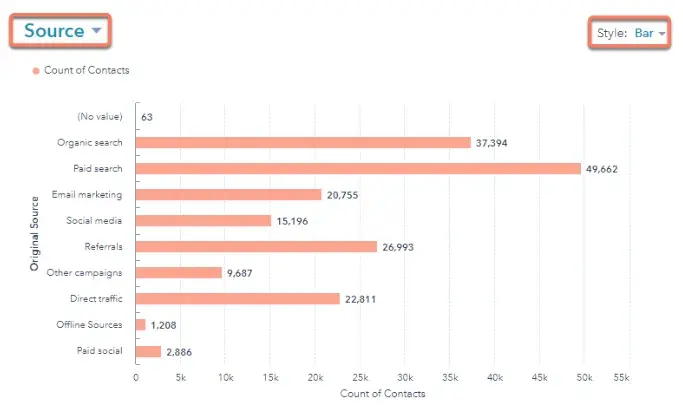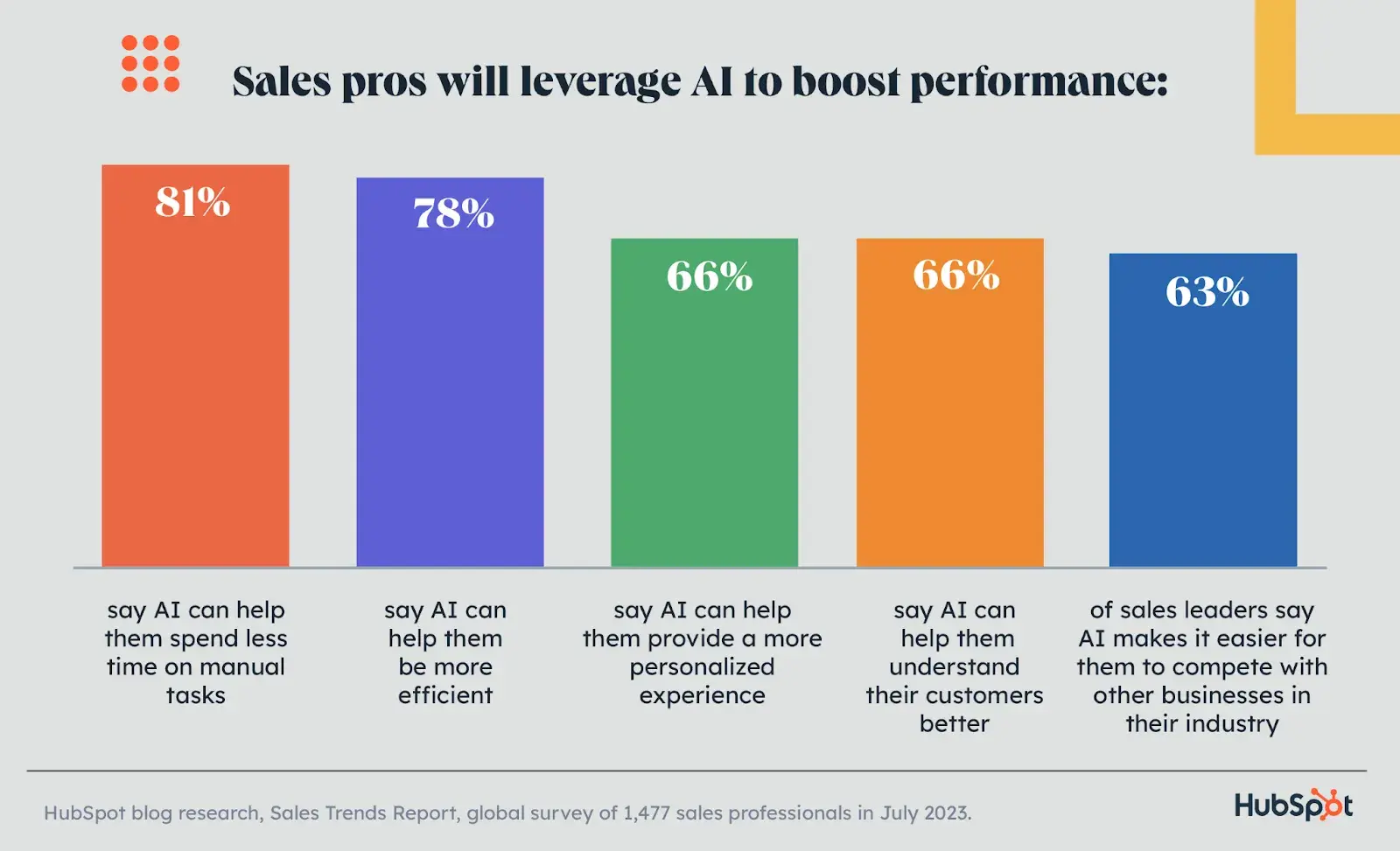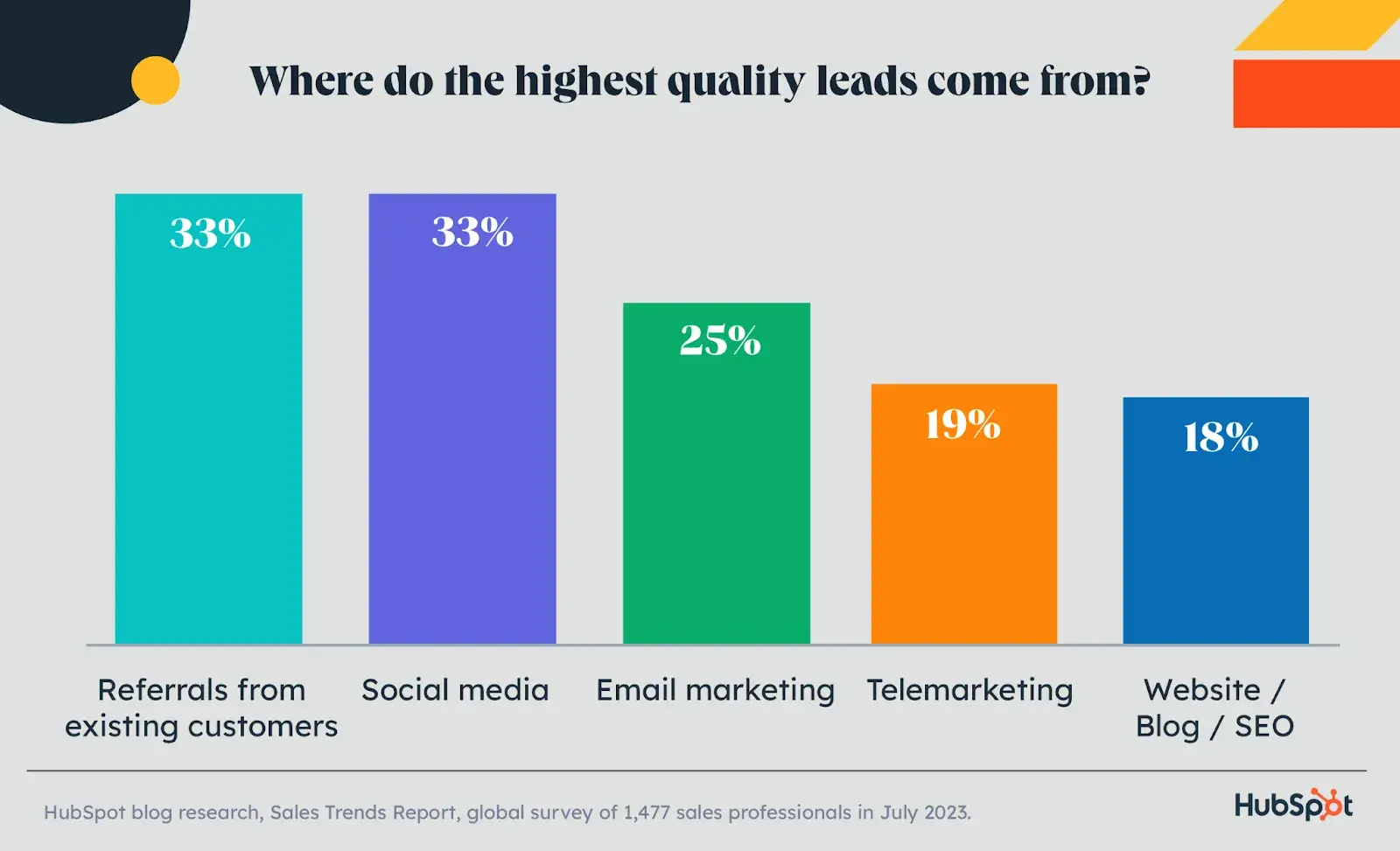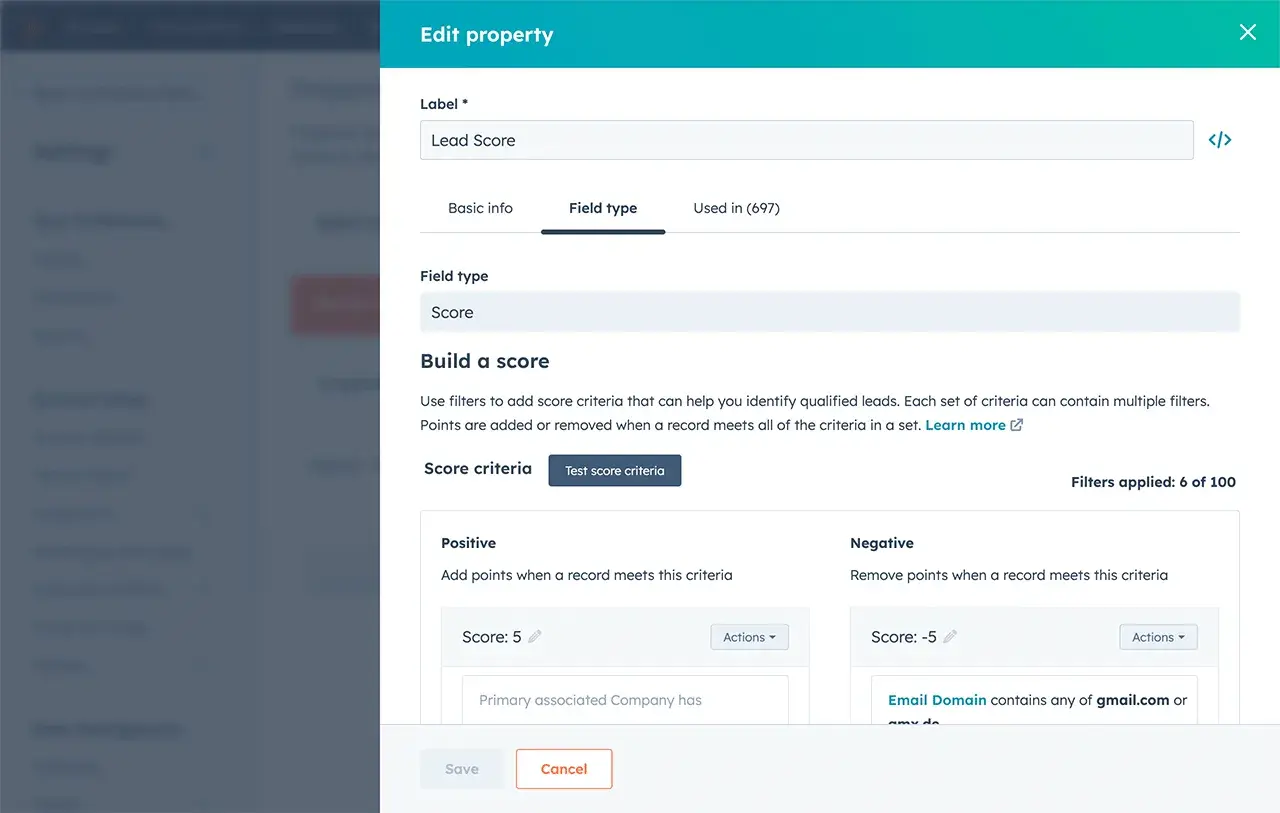Lead Scoring 101: How to Use Data to Calculate a Basic Lead Score
When most people start implementing inbound marketing, they're primarily worried about getting enough new leads in the funnel.

When most people start implementing inbound marketing, they're primarily worried about getting enough new leads in the funnel. But once you have a lot of leads, you need to figure out who‘s really interested in your product and who’s just starting to look around. That's where lead scoring comes in. In this article, I’ll share lead scoring models for you to consider, important data to look at, and best practices for effective lead scoring. Table of Contents Lead scoring is the process of assigning values, often in the form of numerical “points,” to each lead you generate to evaluate the likelihood of them becoming a customer. You can score your leads based on multiple attributes, including the professional information they‘ve submitted to you and how they’ve engaged with your website and brand across the internet. This process helps sales and marketing teams prioritize leads, respond to them appropriately, and increase the rate at which those leads become customers. Learn more about the concept of lead scoring in the video below: Every company has a different model for assigning points to score their leads, but I’ve found one of the most common ways is to use data from past leads to create a value system. How? First, you‘ll take a look at your contacts who became customers to see what they have in common. Next, you’ll look at the attributes of your contacts who didn‘t become customers. Once you’ve looked at the historical data from both sides, you can decide which attributes should be weighted heavily based on how likely they are to indicate someone's a good fit for your product. Lead scoring sounds easy, right? Depending on your business model and the leads in your database, this can quickly become complicated. To make this process a little easier on you, I’m going to walk you through the basics of creating a lead score, including what data you should look at, how to find the most important attributes, and the process for actually calculating a basic score. You may be wondering if lead scoring is outdated or if it’s still a relevant sales method. The short answer is lead scoring is as important today as it has been for years. The methods may have evolved, but the purpose of lead scoring continues to be essential for sales and marketing teams. For starters, lead scoring allows you to prioritize and focus your efforts on leads that are the most likely to convert to customers. And when 53% of salespeople say selling got harder in 2023, I think it’s a good idea to turn your energy towards sales that have a higher chance of closing. Mark Osborne, B2B sales expert and founder of Modern Revenue Strategies, adds that for many businesses, markets are tightening due to uncertainty and higher interest rates, which has resulted in less capital — making every lead even more precious. “Remember the 80/20 rule: that 80% of your revenues come from just 20% of your clients,” suggests Osborne. “This is even more pronounced when expanded to the percentage of leads that become your best clients.” Businesses without systems for scoring and prioritizing the best opportunities are likely spreading themselves too thin across all opportunities and won't win the best clients. Plus, says Osborne, without a lead scoring model in place, you could be losing business to the competition. “Savvy competitors have learned to swarm on the best opportunities as soon as they identify them,” he says, “giving those prospects the highest level of personalized attention and service to win those crucial deals.” Lead scoring models ensure the values you assign to each lead reflect their actual compatibility with your product. Many lead scores are based on a point range of 0 to 100, but every model you create will support a particular attribute of your core customer. Here are six different lead scoring models based on the type of data you can collect from the people who engage with your business: Are you only selling to people of a certain demographic, like parents of young children or CIOs? Ask demographic questions in the forms on your landing pages, and you can use your leads' answers to see how well they fit in with your target audience. One thing I suggest is to remove outliers from your sales team’s queue by subtracting points for people who fall into a category you don’t sell to. For example, if you only sell to a certain geographic location, you might give a negative score to any lead who falls outside the proper city, state, zip code, country, and so on. If some of your form fields are optional (like a phone number, for instance), you might also award extra points to leads who provide that optional information anyway. If you‘re a B2B organization, are you more interested in selling to organizations of a certain size, type, or industry? Are you more interested in B2B organizations or B2C organizations? You can ask questions like these on your landing page forms, too, so you can give points to leads who fit in with your target audience and take points away from leads who aren’t at all what you're looking for. Osborne also suggests tracking external company data on company information such as new leadership, M&A activity, new investments, or a PR crisis as this knowledge “can be valuable in understanding the prospective company's current context and fit with your value proposition to uncover the potential for long-term, profitable engagements,” he says. For Ben Grant, CEO of LearnSales, behavioral data is essential for lead scoring in 2024. “I'm diving deep into behavioral data such as what content [prospects] are engaging with, how often they visit our site, and even the time they spend on specific pages,” he says. “This gives us a clearer picture of their intent.” In my experience, how a lead interacts with your website can tell you a lot about how interested they are in buying from you. Take a look at your leads who eventually become customers: Which offers did they download? How many offers did they download? Which pages — and how many pages — did they visit on your site before becoming a customer? Both the number and types of forms and pages are important. You might give higher lead scores to leads who visited high-value pages (like pricing pages) or filled out high-value forms (like a demo request). Similarly, you might give higher scores to leads who had 30 page views on your site, as opposed to three. What about leads who have changed their behavior over time? If a lead has stopped visiting your website or downloading your offers, they may not be interested anymore. You might take points away from leads who've stopped engaging with your website after a certain period of time. How long — 10 days, 30 days, 90 days — depends on your typical sales cycle. Keep in mind that your sales cycle may look different these days compared to years prior. In 2023, 53% of companies experienced longer sales cycles. If someone opts in to receive emails from your company by filling out an email popup, you may not know how interested that person is in buying from you. Open and click-through rates, on the other hand, will give you a much better idea of their interest level. Your sales team will want to know who opened every email in your lead nurturing series or who always clicked through your offer promotion emails. That way, they can focus on the ones who seem most engaged. You might also give a higher lead score to leads who click through on high-value emails, like demo offers. How engaged a lead is with your brand on social networks can also give you an idea of how interested they are. How many times did they click through on your company's tweets and LinkedIn posts? How many times did they comment or share those posts? In my experience, social media is tied to referrals for generating the highest-quality leads, so it’s not a channel to overlook. If you’re not already collaborating with your marketing team to get this data, start now, recommends Grant. “Our sales and marketing team are in constant communication, ensuring that the criteria we use for scoring are aligned with real-world results,” he says. “This synergy helps refine our lead scoring models and improve accuracy.” Last but not least, you should give negative scores to leads who filled out landing page forms in ways that could indicate they're spam. For example, were first name, last name, and/or company name not capitalized? Did the lead complete any form fields by typing four or more letters in the traditional “QWERTY” keyboard side-by-side? You might also want to think about which types of email addresses leads are using compared with the email addresses of your customer base. If you're selling to businesses, for example, you might take points away from leads who use a Gmail or Yahoo! email address. There's a lot of data to weed through — how do you know which data matters most? Should you find out from your sales team? Should you interview your customers? Should you dive into your analytics and run a few reports? I recommend a combination of all three. Your sales team, your customers, and your analytics reports will all help you piece together what content is most valuable for converting leads into customers, which will help you attach a number of points to certain offers, emails, and so on. Sales reps are the ones on the ground, communicating directly with both leads who turned into customers and those who didn't. They tend to have a pretty good idea of which pieces of marketing material help encourage conversion. Which blog posts and offers do your sales reps like to send leads? You might find some of them telling you, “Every time I send people this certain piece of collateral, it's easier to close them.” This is valuable information. I recommend you find out what those pieces of collateral are and assign points accordingly. While your sales team might claim certain content converts customers, you might find that the people who actually went through the sales process have different opinions. That's okay: You want to hear it from both sides. In fact, according to our 2024 State of Sales Report, building and maintaining a strong rapport with customers is a key focus area for sales professionals. Conduct a few customer interviews to learn what they think was responsible for their decision to buy from you. I suggest you interview customers who have had both short and long sales cycles so you get diverse perspectives. I recommend you also complement all this in-person research with hard data from your marketing analytics. Run an attribution report to figure out which marketing efforts lead to conversions throughout the funnel. Don‘t only look at the content that converts leads to customers — what about the content people view before they become a lead? You might award a certain number of points to people who download content that’s historically converted people into leads and a higher number of points to people who download content that's historically converted leads into customers. Another way to help you piece together valuable pieces of content on your site is to run a contacts report. A contacts report will show you how many contacts — and how much revenue — have been generated as a result of certain, specific marketing activities. Marketing activities might include certain offer downloads, email campaign click-throughs, and so on. Take note of which activities tend to be first-touch conversions, last-touch conversions, and so on, and assign points accordingly. If you have one core customer right now, a single score suffices. But as your company scales, you'll sell to new audiences. You might expand into new product lines, new regions, or new personas. You might even focus more on up-selling and cross-selling to existing customers rather than pursuing new ones. In my experience, if your contacts aren‘t "one size fits all," your scoring system shouldn’t be either. With some marketing platforms, you can create multiple lead-scoring systems, giving you the flexibility to qualify different sets of contacts in different ways. Not sure how to set up more than one score? I’ve gathered a few examples to inspire you: Let’s say, for instance, your sales team wants to evaluate customers on both fit (e.g., is a contact in the right region? The right industry? The right role?) and interest level (e.g., how engaged have they been with your online content?). If both of these attributes are a priority, you can create both an engagement score and a fit score so that you can prioritize outreach to contacts whose values are high in both categories. Say you’re a software company that sells two different types of software via different sales teams to different types of buyers. You could create two different lead scores — one for a buyer’s fit and the other for their interest in each tool. Then, you’d use these respective scores to route leads to the right sales teams. As you grow, you might start to focus on upselling or cross-selling as much as new business. However, keep in mind that the signals that indicate the quality of new prospects and existing customers often look completely different. For prospects, you might look at demographics and website engagement, whereas for existing customers, you might look at how many customer support tickets they've submitted, their engagement with an onboarding consultant, and how active they currently are with your products. If these buying signals look different for different types of sales, consider creating multiple lead scores. There are many different ways to calculate a lead score, but I think the simplest way to do it is this: Your lead-to-customer conversion rate is equal to the number of new customers you acquire, divided by the number of leads you generate. Use this conversion rate as your benchmark. Customers who requested a free trial at some point, customers in the finance industry, or customers with 10-20 employees could be attributes. There‘s a certain kind of art to choosing which attributes to include in your model. You’ll choose attributes based on those conversations you had with your sales team, your analytics, and so on — but overall, it's a judgment call. You could have five different people do the same exercise, and they could come up with five different models. But that's okay as long as your scoring is based on the data we mentioned previously. Calculating the close rates of each type of action a person takes on your website — or the type of person taking that action — is important because it dictates the actions you'll take in response. So, figure out how many people become qualified leads (and ultimately customers) based on their actions or who they are in relation to your core customer. You'll use these close rates to actually “score” them in the step below. Look for the attributes with close rates that are significantly higher than your overall close rate. Then, choose which attributes you’ll assign points to, and if so, how many points. Base the point values of each attribute on the magnitude of their individual close rates. The actual point values will be a little arbitrary, but try to be as consistent as possible. For example, if your overall close rate is 1% and your “requested demo” close rate is 20%, then the close rate of the “requested demo” attribute is 20X your overall close rate — so you could, for example, award 20 points to leads with those attributes. The simple method above for calculating a lead score is a great start. However, the most mathematically sound methods employ a data mining technique, such as logistic regression. Data mining techniques are more complex and often more intuitive than your actual close rates. Logistic regression involves building a formula in Excel that’ll spit out the probability that a lead will close into a customer. This is more accurate than the technique I outlined above since it’s a holistic approach that takes into account how all of the customer attributes — like industry, company size, and whether or not someone requested a trial — interact with one another. If you prefer a less complex lead-scoring method, I think the manual approach above is a great place to start. Creating a lead score can do great things for your business: improve the lead-handoff process, increase lead conversion rate, improve rep productivity, and more. But, as you can see from the two methods above, coming up with a scoring system can be a time-consuming task when done manually. Plus, coming up with scoring criteria isn‘t "set it and forget it." As you get feedback from your team and stress-test your scores, I’ve found you’ll need to tweak your lead-scoring system regularly to ensure it remains accurate. Wouldn't it be easier if technology could eliminate the manual setup and continuous tweaking, leaving your team more time to build relationships with your customers? That's where predictive scoring comes in. Predictive lead scoring uses machine learning to parse through thousands of data points in order to identify your best leads, so you don't have to. Predictive scoring looks at what information your customers have in common, as well as what information the leads that didn't close have in common, and comes up with a formula that sorts your contacts by importance based on their potential to become customers. This allows you and your sales team to prioritize leads so you're not harassing those who aren't (yet) interested and engaging those who are. The best part about predictive scoring? As with any application of machine learning, your predictive score gets smarter over time, so your lead follow-up strategy will optimize itself. We’ve covered a lot so far, so I want to wrap it up with a few best practices I learned from the sales leaders I spoke to. Here are some lead scoring best practices to follow if you want to improve your sales in 2024. In the age of AI, sales professionals would be wise to use one of the numerous AI tools to their selling advantage, especially during the lead scoring process. Not only can AI tools improve efficiency, but 66% of sales pros say that AI helps them provide a personalized experience and better understand their customers. Grant is also taking advantage of AI’s power to personalize data. “We’re leveraging AI to analyze patterns and predict which leads are most likely to convert,” he says. “Machine learning models can adapt and get more accurate over time, which is a huge step up from traditional lead scoring methods.” I think one of the best parts about lead scoring is that it’s an objective method. When the data indicates how interested a prospect is, that’s something you’ll want to lean into. Data is one of the most important resources sales teams and marketers have at their disposal, and lead scoring has become even more data-driven with the tools available today. If you want to save time spent on unqualified leads and prioritize sales-ready ones with data-driven decisions, then your sales team should use a lead scoring model that makes it easy to organize and understand your data. If you think lead scoring models are outdated, it could be because the traditional methods didn’t take into account real-time industry or business changes. “Lead scoring is no longer a set-it-and-forget-it deal,” says Grant. “We’re making real-time adjustments based on the latest data. This agility helps us stay ahead of the curve and respond to changing market conditions.” There are so many lead generation tools available to help your sales team make real-time decisions and properly qualify inbound leads. Scoring your leads can go a long way in determining which leads are good fits and interested in your offering and which might need more nurturing before being sales-ready. Check out our lead scoring templates to get started defining your criteria and assigning points! Editor's note: This post was originally published in January 2019 and has been updated for comprehensiveness.
What is lead scoring?
Why is lead scoring important?
Lead Scoring Models
1. Demographic Information
2. Company Information
3. Behavioral Data
4. Email Engagement
5. Social Engagement
6. Spam Detection
How to Determine What Data to Look At
Talk to your sales team.
Talk to your customers.
Turn to the analytics.

Is one lead score enough?
Fit vs. Interest
Multiple Personas
New Business vs. Up-sell
How to Calculate a Basic Lead Score
Featured Resource: Free Lead Scoring Template
Manual Lead Scoring
1. Calculate the lead-to-customer conversion rate of all of your leads.
2. Pick and choose different attributes of customers who you believe were higher quality leads.
3. Calculate the individual close rates of each of those attributes.
4. Compare the close rates of each attribute with your overall close rate and assign point values accordingly.
Logistic Regression Lead Scoring
Predictive Lead Scoring
Featured Resource: Predictive Lead Scoring Software
Lead Scoring Best Practices
Leverage AI and machine learning.

Lead with data.
Make real-time adjustments.
Improve Your Sales With Lead Scoring

 Aliver
Aliver 










_1.jpg)
























